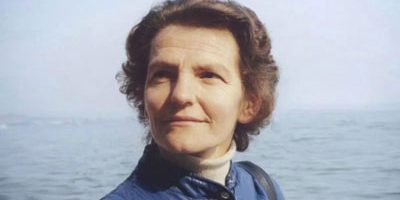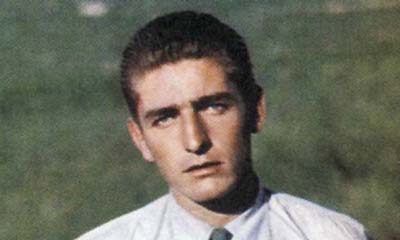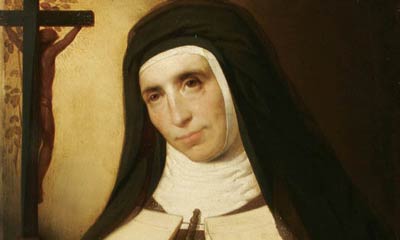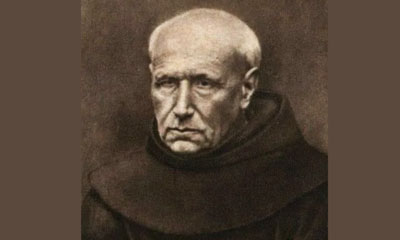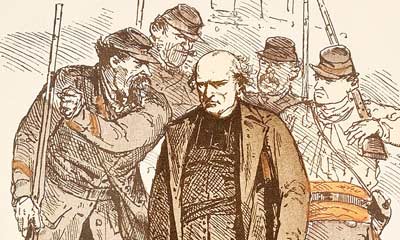November 6, 2024
Blessed Maria Laura Mainetti
Dear Friends,
“Never think of yourself, be a quiet presence, be content with little, know how to give and receive.” Such were the maxims that Teresina, a young Italian girl of eighteen, penned in her spiritual diary in 1957, shortly before entering the convent. On August 25, 1964, when she was about to take her perpetual vows, Teresina, now Sister Maria Laura, wrote: “To serve Christ is to reign… may the joy of my service at all times be conformed to His Divine Will.” She was an educator with a burning love of God and neighbor, and on June 6, 2000, she was killed by three girls who were followers of Satan. Twenty years to the day after this tragedy, by decree of Pope Francis, Sister Maria Laura Mainetti was proclaimed blessed, receiving the title of martyr in odium fidei, in hatred of the faith.
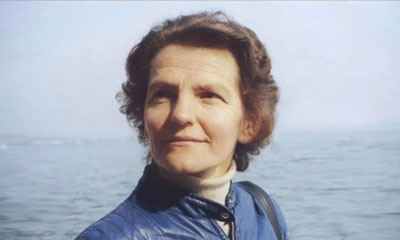 Teresina Mainetti was born in Colico, Lombardy (northern Italy), on August 20, 1939. Her mother, who had already borne twelve children, died from complications of childbirth. Teresina’s eldest sister, Romilda, took care of the youngest until their father, Stefano, remarried. He lived frugally, educating his children to a demanding faith. Teresina, a diminutive child, was gentle and shy, and her gaze was profound. She caught the benevolent eye of Sister Maria Amelia, of the Daughters of the Cross, who took special care of her before finding a generous woman prepared to pay for her secondary education. Thus Teresina was able to study in Parma, at the Laura Sanvitale Institute run by the Daughters of the Cross. Thanks to her association with these nuns, Teresina decided to consecrate herself entirely to God.
Teresina Mainetti was born in Colico, Lombardy (northern Italy), on August 20, 1939. Her mother, who had already borne twelve children, died from complications of childbirth. Teresina’s eldest sister, Romilda, took care of the youngest until their father, Stefano, remarried. He lived frugally, educating his children to a demanding faith. Teresina, a diminutive child, was gentle and shy, and her gaze was profound. She caught the benevolent eye of Sister Maria Amelia, of the Daughters of the Cross, who took special care of her before finding a generous woman prepared to pay for her secondary education. Thus Teresina was able to study in Parma, at the Laura Sanvitale Institute run by the Daughters of the Cross. Thanks to her association with these nuns, Teresina decided to consecrate herself entirely to God.
In 1957, however, she became ill with pulmonary tuberculosis. Fearing that she would not be accepted into the convent, she asked her brother Amedeo to pray for her: “You pray, and the Lord will do the rest.” She recovered completely and was soon able to enter the Daughters of the Cross in Colico as a novice. For the rest of her life, she would say a Hail Mary every day in gratitude to Amedeo, who returned the favor. She explained her decision to become a nun in this way: “A priest said to me after confession: ‘You must do something beautiful for others.’ It was a demanding statement; what is more, its resonance filled me with joy. I felt that I was going to give full meaning to my life. The Daughters of the Cross, who lived in my part of the world, to me seemed the embodiment of this ideal.”
The congregation of the Daughters of the Cross was founded in France in 1807, in the diocese of Poitiers, by Sts André-Hubert Fournet and Jeanne-Élisabeth Bichier des Âges for the purpose of educating children and caring for the sick. By the time St Jeanne-Élisabeth died in 1838, the congregation already totaled 117 communities, and in 1851 it founded a convent in Parma, Italy. There are currently 400 Daughters of the Cross carrying out their apostolate in twelve countries.
On February 11, 1958, one hundred years after the first apparition in Lourdes, Teresina received the religious habit and took the name of Sister Maria Laura. Her sisters in the novitiate later remembered: “Despite her frail constitution, she was always the first to offer herself for any kind of service, and she would be ready on the spot! She was very attentive to others and oblivious of herself. Ever serene, she chose all the lowliest tasks. She was gentle and humble in her ways, and made everyone feel loved and valued.”
On August 15, 1959, Sister Maria Laura took her first vows in Rome. The following year, she completed her studies as an educator at the Magistral Institute in Parma, and began teaching at the elementary school run by the Daughters of the Cross. As early as 1963, she was sent to Chiavenna, not far from her birthplace; she was to return there for good in 1984 as a teacher and head of boarding at the secondary school for girls run by her congregation. In 1987, she was also appointed superior of the community.
Testimonials about Sister Maria Laura highlight the contrasts in her personality. They reveal a clear portrait of her as strong and determined woman, yet gentle, slight and frail of body, who did good in silence, without seeming to attach any importance to it, “unassumingly.” When she did speak, it was either to talk about God and the mission, or to make excuses for someone else. She was so discreet in her ways that, for many years, she was considered to be insignificant. The congregation’s General Assistant remembers: “She was a gentle, smiling, attentive and tactful woman, who took care of every detail… She would walk among the people, handing out greetings and smiles, like a good sister who took an interest in everyone… Even though I sometimes sensed how exhausted she was, she never let her fatigue burden others.” Filled with apostolic zeal, Maria Laura was thrilled by every parish initiative and yearned to be a catechist. After three years’ training, she became one.
Come In to Pray, Come Out to Love
A sister in Chiavenna remarked: “She never seemed tired, yet we knew she was in poor health. Where did she find the energy she showed us in the community, when she was so frail? The answer is very clear: in her unconditional love for Jesus in the Eucharist and for the Word of God, the nourishment which she so loved. The bond between prayer and action in her life was well expressed by a phrase written on the door of the community’s oratory: ‘Come in to pray, come out to love.’”
Sister Maria Laura was well aware of the decline in faith among the population, in which secularization and consumerism were rampant. In a 1997 letter, she let her suffering show when a Catholic school in Chiavenna closed its doors: “Unfortunately, next year there will no longer be an elementary school of our institute here, because not enough children have enrolled. Is it the low birth rate or the lack of interest in the school? I think it’s both. Hopefully, it’s not because we’re not sufficiently credible! Yes, that is also a risk: no longer being light and salt for those whom we approach.” Pope John Paul II had written earlier:
“The temptation today is to reduce Christianity to merely human wisdom, a pseudo-science of well-being. In our heavily secularized world a ‘gradual secularization of salvation’ has taken place, so that people strive for the good of man, but man who is truncated, reduced to his merely horizontal dimension” (Redemptoris Missio, no. 11), and to mere earthly hope.
During an international meeting of her Order’s nuns in France, Sister Maria Laura answered a question about the mission of the Daughters of the Cross: “We are sent to teach and to heal, thus announcing the salvation that comes to us from the Cross and bearing witness to the presence of the Triune God in the midst of mankind.” Her preference went to the young, whom she saw as fragile, disoriented and subject to manipulation. She strove to inspire them, restore their confidence and also, if necessary, to correct them firmly. A former student testified: “Sister Maria Laura was strict when it came to our late-night excursions in the dormitory corridors, but she was also cheerful and took part in our jokes and games.” Another student confided in 2003: “This sister had God’s eyes, filled with love. She was my mother, my father, my friend, my haven. At a terrible time when I had no family, she was the only person who loved me and cared for me. She spent nights by my bed; while I wept in despair, she never abandoned me… When I said to her: ‘Sister Maria Laura, nobody loves me,’ she would smile and show me the crucifix.” Young people were her soft spot, her passion; and yet, it was young people who set a deadly trap for her.
A Death Trap
At the turn of the century, Chiavenna was a peaceful town of 7,500 inhabitants, located in an Alpine valley close to the Swiss border in Lombardy. First evangelized in ancient times by St Abundius, it is part of the diocese of Como, where religious practice is high. The Daughters of the Cross have been established there since 1905. On June 6, 2000, at 9.45 pm, Sister Maria Laura received a phone call from a teenage girl, “Erica,” who claimed to be pregnant and called for her help. The nun did not hesitate; she went out alone, at night. The next morning, her body was found lacerated with knife wounds at the entrance to a public park. On June 29, following a rigorous investigation, the Carabinieri arrested three teenage girls from Chiavenna: Ambra (17), Milena (16) and Veronica (17), on charges of premeditated murder. They were soon to confess: “We lured this Sister into a trap and killed her; we wanted to do something out of the ordinary and experience thrilling sensations.”
Questioning by the police made it possible to reconstruct the sequence of dramatic events. Around June 1, the leader of the trio, Ambra, contacted Sister Maria Laura, calling herself Erica and claiming to be pregnant after having been raped; her family, she said, wanted her to have an abortion, but she wanted to keep her baby; she did not know where to turn. Sister Maria Laura pledged her unconditional support; she even offered to take her in at the convent, at least until the end of her pregnancy. On the evening of June 6, “Erica” called the nun again, urging her to “come at once”; a meeting place was arranged on the Piazza Castello. As a precaution, the nun informed the parish Archpriest, Don Ambrogio Balatti. He was uneasy about the situation and joined her on his bicycle, but she asked him not to intervene so as not to intimidate the young girl, convincing him to leave.
Having established contact, Ambra lured Sister Maria Laura to a secluded spot under the pretext that she had left her bags there. Milena and Veronica appeared at that point, introducing themselves as friends of hers. The four women made their way down a deserted alleyway; suddenly, one of the three girls hit the nun with a brick, and then with a kitchen knife. The three miserable creatures carried their wounded victim to a nearby municipal park, and forced her to her knees, in a symbolic and ritual posture of submission. They struck her on the head, insulted her and took it in turns to inflict eighteen stab wounds, six each (666 is the symbolic number of the Beast of the Apocalypse—Rev 13:18); a 19th blow was inflicted “by mistake.” After appealing in vain to the mercy of her assailants, Sister Maria Laura understood that she was going to die, and surrendered herself to Providence. Out loud, she prayed for those who were killing her: “Lord, forgive them!” The three murderesses abandoned their dying victim and walked away.
The Mark of the Devil
The “key” to this crime is Satanism: that much became clear from the investigation and the concurring confessions of the three suspects, who were questioned separately. The judge’s verdict states: “Their sole motive was to encounter Satan and obtain from him a manifestation of his existence and power. To this end, they decided to immolate an innocent victim to Satan.” Initially, they came into contact with occultist and then satanist circles by reading magazines that were circulating in their schools; together, they listened to rock music with Satanic lyrics. They invoked the evil spirit through a ritual that involved saying Christian prayers with the words reversed; they stole and then burned a Bible in front of a church, in the presence of their friends. Ambra, Veronica and Milena had entered into a “blood pact,” binding them together inseparably in view of their murderous plan. Their private journals revealed a wealth of hymns and invocations to Satan, along with drawings of inverted crosses. Their bodies bore the scars of self-mutilation, another common sign of collusion with Satan.
By their criminal act, the three girls declared war on the Catholic religion, to which they belonged by Baptism; they wanted the “innocent victim” immolated to Satan to be a priest or nun. They chose Sister Maria Laura, who seemed an easy prey because of her frail physique. During the lower court trial, the ringleader, Ambra, was deemed irresponsible due to her youth and mental aberration. On appeal, however, this ruling was overturned in April 2002, the prosecutor Maria Cristina Rota having demonstrated that the three accused were fully aware of the gravity of their act and had deliberately chosen to kill; no adult had suggested the crime, they were its sole instigators. They had not shown the slightest sign of remorse since their arrest. In 2003, they were sentenced to lengthy terms of imprisonment.
The parish priest of Chiavenna, Don Ambrogio reflected: “How is it possible that three teenage girls, girls from our own town, could have conceived and carried out such a horrendous crime with such lucidity and determination? I have yet to find an answer… Their deeds, senseless as they are in their wanton cruelty, have confirmed to me the very real presence of the Evil One throughout the course of human life.”
The Revelation of God transmitted by the Catholic Church is absolutely clear on the existence of the devil: “Satan or the devil and the other demons are fallen angels who have freely refused to serve God and his plan. Their choice against God is definitive. They try to associate man in their revolt against God” (Catechism of the Catholic Church, no. 414). In the petition of the Our Father: But deliver us from evil, “evil is not an abstraction, but refers to a person, Satan, the Evil One, the angel who opposes God” (CCC, no. 2851).
How do we recognize Satan’s presence? Our Lord gives us the answer in His words to the Pharisees: You are of your father the devil, and your will is to do your father’s desires. He was a murderer from the beginning, and has nothing to do with the truth, because there is no truth in him. When he lies, he speaks according to his own nature, for he is a liar and the father of lies (Jn 8:44). Lies and homicide—these are the two signs of Satan’s presence. The lie of all lies is the denial of God, the rejection of His commandments and the practical atheism that gives God no place in life. A society that rejects God and Jesus Christ thereby puts itself under the yoke of Satan and inevitably comes to despise human life.
Burning Bridges
F?or this purpose, the Son of God appeared, that he might destroy the works of the devil (1 Jn 3:8). By his death on the Cross, in an act of perfect obedience to his Father, Jesus Christ defeated the devil. By following Christ, every baptized person receives the power to defeat Satan. Every Christian must follow in His footsteps. In a catechesis on Baptism, Pope Francis stressed: “It is not possible to adhere to Christ by placing conditions. It is necessary to detach oneself from certain bonds in order to truly embrace others. One is either well with God or well with the devil. For this reason, the renunciation and the act of faith go together. It is necessary to burn some bridges, leaving them behind, in order to undertake the new Way which is Christ” (May 2, 2018).
Priests tasked with performing exorcism prayers, as well as doctors and educators, are observing a sharp upsurge in practices involving the devil in our modern world. A subculture of Satanism is being promoted on social media by countless sites aimed at young people. To the question “How do we counter the power of Satanism?”, the International Association of Exorcists replies: “These demonic propositions represent a form of perversion so far-reaching that it should have no place in a civilized society… because worshippers of Satan present the Commandments and obedience to God as a threat to freedom, self-fulfillment and happiness. In reality, the opposite is true: it is Satan who threatens the freedom, happiness, personal fulfillment and eternal salvation of every human being, as well as peace between peoples and nations, and the true progress of mankind. Unconditional adherence and obedience to God is what makes us truly free, for in God we find the authentic and lasting happiness for which our hearts yearn, the full realization of our existence both in this earthly life and in eternity.”
A Mystery Illuminated by Christ
How are we to understand that God can allow moral evil to exist under the devil’s influence? “For almighty God…, because he is supremely good, would never allow any evil whatsoever to exist in his works if he were not so all-powerful and good as to cause good to emerge from evil itself” (CCC, no. 311, St Augustine, Enchir. 11, 3). “The fact that God permits physical and even moral evil is a mystery that God illuminates by his Son Jesus Christ who died and rose to vanquish evil. Faith gives us the certainty that God would not permit an evil if he did not cause a good to come from that very evil, by ways that we shall fully know only in eternal life” (CCC, no. 324).
In a sermon on the Passion of Christ, St Leo the Great points out: “The devil’s own malice deceived him: he inflicted on the Son of God a torment that was to become a remedy for all the sons of men. He spilled the innocent blood that would be a ransom and a beverage for the world as it awaits its reconciliation” (Sermon 11 De Passione). The devil, who seduced and deceived the murderers of Sister Maria Laura, suffered defeat precisely where he had expected to triumph: the martyr’s heroic act of forgiveness is now known and celebrated all over the world. In prison, the three young girls gradually embarked on a path of repentance. One of them, Milena, would write to the nuns in Chiavenna: “I lured Sister Maria Laura into a trap, killed her and, while we were in the act of murdering her, she forgave us… Now I find in her the comfort and grace to endure everything. I pray unceasingly and am sure that she will help me to become a better person.”
Having followed the commemoration of the martyrs of the 20th century during the Holy Year 2000, Sister Maria Laura confided to the Archpriest of Chiavenna: “We do what we can, but we are never able to give ourselves entirely; such a total gift is found in martyrdom, but that is for God to decide.”
Only a few days before her death, in a letter she wrote to a family grieving in the wake of a great bereavement, Sister Maria Laura left behind words which, in the light of events, resonate as an anticipated surrender to Providence: “Who are we to want to fathom, to explain, to understand the plans of God the Father, which are fulfilled even out of human wickedness? This is exactly what happened to Jesus. And all that happens is in accordance with a plan of love, a plan of salvation.” We may associate ourselves with the prayer offered in July 2000 by Bishop Alessandro Maggiolini of Como: “Sister Maria Laura, we ask you to beseech God on our behalf; on behalf of our families, that they may be ever more united in the Lord; on behalf of our young people, that they may embrace and revive the tradition of humanity and Christianity that has been bequeathed to them; on behalf of a somber and faltering society, so often deprived of authentic ideals, such as the one in which we live; on behalf of the Church as a whole. Thank you, Maria Laura, our blessed Sister, for having existed among us. Godspeed; wait for us!”


